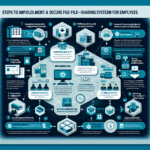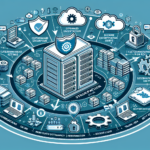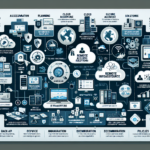Optimizing IT infrastructure for secure data sharing involves implementing a combination of robust hardware, software, policies, and best practices. As an IT manager, here’s a comprehensive guide to achieve this:
1. Assess and Audit Current Infrastructure
- Identify critical data: Classify data based on sensitivity and importance (e.g., public, confidential, restricted).
- Evaluate current security gaps: Conduct a thorough security audit to identify vulnerabilities in your data sharing processes.
- Understand compliance requirements: Ensure your infrastructure aligns with applicable regulations (e.g., GDPR, HIPAA, CCPA).
2. Implement a Secure Data Sharing Architecture
- Centralized storage: Use enterprise-grade storage solutions (e.g., SAN, NAS) that support secure file sharing with encryption capabilities.
- Role-based access control (RBAC): Implement RBAC to ensure users only access the data they need.
- Zero-trust architecture: Adopt a zero-trust model where every access request is verified regardless of location or device.
3. Data Encryption
- At-rest encryption: Ensure data stored in your storage systems is encrypted using tools like BitLocker (Windows), LUKS (Linux), or vendor-specific encryption tools.
- In-transit encryption: Use secure transmission protocols such as TLS/SSL or SFTP for data sharing.
- Key management: Deploy a secure key management system (e.g., HashiCorp Vault, AWS KMS) to manage encryption keys.
4. Secure File Sharing Solutions
- Enterprise file sync and share (EFSS): Use solutions like Microsoft OneDrive for Business, Google Workspace, or Dropbox Business with advanced security configurations.
- On-premise file sharing: Deploy tools like Nextcloud or ownCloud for private, secure file sharing.
- Data Loss Prevention (DLP): Implement DLP tools to prevent unauthorized sharing or leakage of sensitive data.
5. Leverage Virtualization and Containers for Isolation
- Virtualization: Use virtual machines to isolate sensitive environments from others, ensuring that data sharing is compartmentalized.
- Kubernetes and container security:
- Use network policies to isolate Kubernetes pods and namespaces.
- Integrate security tools like Falco or Aqua Security for runtime security.
- Scan container images for vulnerabilities before deployment.
6. Multi-Factor Authentication (MFA)
- Enforce MFA: Require MFA for all users accessing shared resources to prevent unauthorized access.
- Single Sign-On (SSO): Integrate SSO solutions for streamlined, secure user authentication.
7. Network Security
- Segment the network: Use VLANs or software-defined networking (SDN) to segment data sharing environments.
- Firewall configurations: Implement robust firewall rules to restrict access to data-sharing services.
- Intrusion detection/prevention systems (IDS/IPS): Deploy tools like Snort, Suricata, or commercial solutions to monitor and block malicious traffic.
8. Backup and Disaster Recovery
- Regular backups: Schedule automated backups of all critical data to a secure location.
- Immutable backups: Use storage solutions like WORM (Write Once Read Many) to prevent data tampering.
- Offsite storage: Store backup copies in geographically dispersed locations to ensure data availability during disasters.
9. Secure Endpoint Devices
- Endpoint security: Deploy endpoint protection solutions (e.g., CrowdStrike, SentinelOne) to secure devices used for accessing shared data.
- Mobile Device Management (MDM): Use MDM solutions like Microsoft Intune or VMware Workspace ONE to manage and secure mobile devices.
10. AI and Machine Learning for Anomaly Detection
- AI-driven monitoring: Leverage tools like Splunk, ELK Stack, or SIEM solutions that integrate AI to detect unusual data access patterns or potential breaches.
- Behavior analysis: Use machine learning to profile user behavior and identify anomalies that might indicate malicious activity.
11. Implement Secure Collaboration Tools
- Secure messaging: Use encrypted messaging platforms like Signal, Microsoft Teams, or Slack with enhanced security settings.
- Version control: Use tools like GitHub or GitLab with strict access controls for code and document collaboration.
12. Educate and Train Users
- Security awareness training: Conduct regular training sessions on secure data sharing practices and phishing awareness.
- Data sharing policies: Create and enforce clear policies on how data can be shared, with whom, and through which channels.
13. Monitor and Audit Regularly
- Continuous monitoring: Use monitoring tools to track data access and sharing activities in real-time.
- Audit logs: Enable detailed logging and regularly review logs for suspicious activities.
- Compliance audits: Perform periodic compliance audits to ensure adherence to security standards.
14. Leverage GPUs for Secure Computation (Optional)
- Homomorphic encryption: Use GPUs to accelerate secure computation methods (e.g., homomorphic encryption) for sharing data while preserving privacy.
- AI model training: Leverage GPUs for training AI models on secure datasets without exposing sensitive information.
15. Incident Response and Recovery Plan
- Develop an incident response plan: Clearly define steps to take in case of a data breach.
- Simulate breach scenarios: Conduct tabletop exercises to test the readiness of your team and infrastructure.
By implementing these strategies, you can optimize your IT infrastructure to securely share data while maintaining compliance, minimizing risks, and ensuring operational efficiency.
How do I optimize IT infrastructure for secure data sharing?



